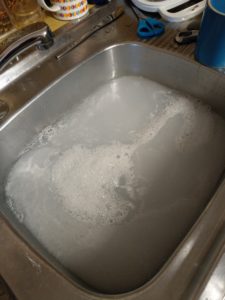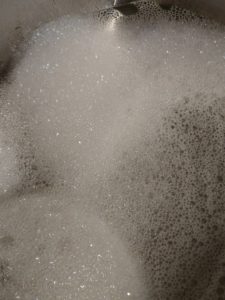
When I embarked on my journey to replace all commercial cleaning products in my home I was confronted with lots of online articles, low tox books and advice from others who had walked this path before me. I mentioned in a earlier post that this was so overwhelming that I had to develop a strategy to help work through all the options. One of the products that gave me the most grief was dish washing liquid. I had the dishwasher tablets sorted but I struggled for months to find a recipe for dish washing liquid that would produce something that was acceptable. That’s why the title of this post mentions the word ‘saga’ – as far as I was concerned it was epic and kept me awake at night for weeks!
Why was it so important to make my own dish washing liquid?
Commercial dish washing liquids contain a whole range of chemicals that are potentially bad for us and the environment including fragrances, surfactants, colours and preservatives. Whilst there is much debate about the level of danger and toxicity associated with many of the components, particularly the surfactants, I decided to that I would err on the side of caution. After all my goal was to reduce the level of toxic chemicals in the home. At the very least I wanted to rid the house of fake fragrances. So I decided to make my own dish washing liquid so would know exactly what was in it. However, in saying this I need a product for washing my dishes that actually does the job.
As I found out after lots of experimenting, some of the most common recipes out there were just not good enough! The easy part was making a product without the strong fragrance i.e. I could substitute Essential Oils for these. But making something that would actually clean my dishes was another story!
Why was it so difficult to find a suitable recipe and solution?
Most of the recipes I found were based on Castile soap. This is a wonderful soap for many different products. I use it as the base for hand wash, shower gel, clothes washing liquid, shower cleaning spray, make up remover etc. But as a dish washing liquid it was severely lacking. I know that many people would argue with me on this but in my opinion it just doesn’t do the job.
There are several things that I don’t like about Castile soap for dish washing:
The water goes milky white and then just looks disgusting.
It has an unpleasant smell.
It does not foam or lather up very well.
It is not very good for cleaning greasy dishes e.g. after a roast.
I hated the way the water pooled in the sink after the washing up was done.
Without a surfactant it was difficult to wipe down the sink cleanly.
You might think me strange to say this but I started dreaming about clean sinks and washing dishes! I became quite stressed about it. I found a recipe that mixed Castile Soap with Washing Soda. Unfortunately that turned into a glue like substance that was not at all effective as a dish washing detergent!!
The importance of a surfactant
It was time for a serious rethink.
Now, the DIY purists will tell you that you don’t need a sink full of suds or bubbles to get the dishes clean. But I respectfully disagree. The bubbles are a product of the surfactants in the detergent and it is the surfactants that actually enable the break down of the interface between water and oils and/or dirt. So if there are not many bubbles there won’t be much cleaning happening either. Remember I said above, I’m all for safer products – as long as they do the job. So I did some research on surfactants and set out to experiment.
Anionic Surfactants
Anionic surfactants are commonly found in laundry detergents, dishwashing detergents etc. They can cause skin irritation. Two of the most popular anionic surfactants are Sodium lauryl sulfate (SLS) and Sodium laureth sulfate (SLES). Anionic surfactants can be produced from a range of raw fats and oils, including: soybean, palm, tallow, and coconut. However some may also be derived from petroleum. Although the information on the safety of these compounds is confusing there has definitely been an interest in development of milder anionic surfactants such as ‘potassium cocoate’, and non-ionic surfactants such as decyl glucoside which are said to reduce skin irritation. So I thought I would try one of these.
Decyl Glucoside
I found a recipe for dish washing liquid that was based on Castile Soap and contained decyl glucoside. I used this for a while, playing around with the amount of surfactant added. However, I was disappointed with the result. Even with the addition of the surfactant, the cleaning power of the mix was not satisfactory. The detergent did not hold the foam and I was constantly having to refill the sink with fresh water and detergent. So it time to move on to something else.
Success at Last
One night whilst trawling through endless recipes on blogsites I found what I hoped would be a recipe that worked. The recipe was based on something called Sal Suds rather than Castile Soap and mixed Washing Soda with Sal Suds and a small amount of vegetable glycerin.

Sal Suds contains Sodium Lauryl Sulfate (SLS), sourced from vegetable sources. Sal Suds is not soap-based and is formulated especially for all-purpose hard-surface cleaning. You may want to avoid this but I can live with it. It is actually a balanced formulation of naturally derived surfactants with pure fir and spruce essential oils: it cleans and rinses extremely well and I have found it to be mild and gentle on my skin.
If you are interested in where to find this product I included details in a previous post.
For the past 6-8 months I have been making this recipe and using it daily for the washing up. I would give you the recipe but recently I tried something different that works even better. For the last few weeks I have just been using diluting the Sal Suds and it works a treat, saving the cost and extra effort associated with the Washing Soda. I dilute 1/3 cup of Sal Suds with water to fill a Sal Suds (970 ml) bottle almost to the top. This makes a fairly strong foam and cleans everything very nicely.
Is There Hope for Castile Soap?
I am happy with my Sal Suds but I found a recipe for body wash the other day that made me think that there might still be some hope for Castile Soap lovers. The recipe for body wash contained coconut milk and Castile Soap. This mix foams up really well in the shower!! Strange mix your say? Not really because SLS is often derived from coconut. So today I tried a mix of coconut milk and Castile in the kitchen sink. I mixed 30 ml of Coconut Milk with 40 ml of Castile Soap, added a dash of vegetable glycerin and about 5 drops of Lime Essential Oil. The water still went milky but the mix did foam up quite well and stayed bubbly while I was washing up.
I added about 2-3 tablespoons of each ‘detergent’ with hot water and filled the sink about half way.
Here are some photos of the foam produced:



You can see for yourself that the addition of the Coconut Milk improved the foam quality. But don’t take my word, try it yourself.
This was quite a saga – much more complicated than the processes for other products around the home.
I think there a few messages here:
Just because someone else writes about a product being great you never know until you try it.
Don’t fell guilty if you don’t like it, just look for another way and try again!
I will continue with the Sal Suds but now I know that if I run out I have an alternative which is effective too.
We hope you will join us at Helpful By Nature by subscribing to our email list. We would love to hear from you, take your questions and provide answers if we are able.

Until next time,
Gillian (and Andrew)

